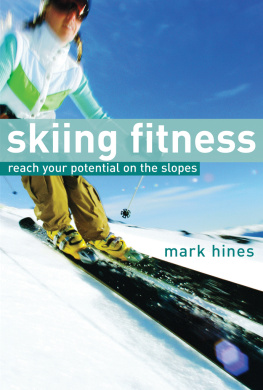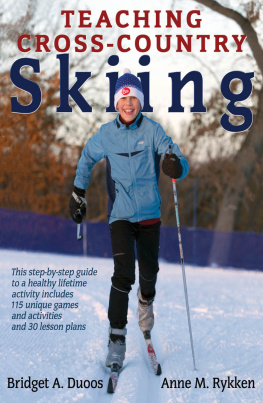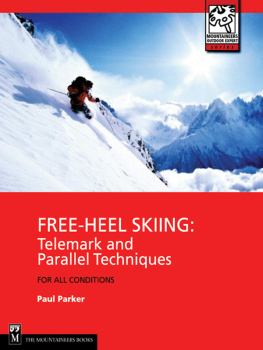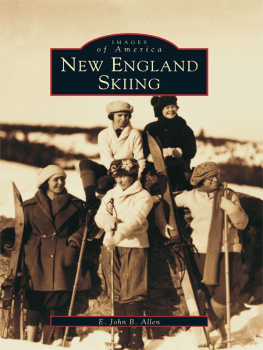Library of Congress Cataloging-in-Publication Data
Kipp, Ronald W.
Alpine skiing / Ronald W. Kipp.
p. cm. -- (Outdoor Adventures)
Includes bibliographical references.
ISBN-13: 978-0-7360-8355-3 (soft cover)
ISBN-10: 0-7360-8355-3 (soft cover)
1. Skis and skiing--Training. I. Title.
GV854.85.K57 2011
796.935--dc22
2011008676
ISBN-10: 0-7360-8355-3 (print)
ISBN-13: 978-0-7360-8355-3 (print)
Copyright 2012 by Ronald W. Kipp
All rights reserved. Except for use in a review, the reproduction or utilization of this work in any form or by any electronic, mechanical, or other means, now known or hereafter invented, including xerography, photocopying, and recording, and in any information storage and retrieval system, is forbidden without the written permission of the publisher.
This publication is written and published to provide accurate and authoritative information relevant to the subject matter presented. It is published and sold with the understanding that the author and publisher are not engaged in rendering legal, medical, or other professional services by reason of their authorship or publication of this work. If medical or other expert assistance is required, the services of a competent professional person should be sought.
The web addresses cited in this text were current as of February 2011, unless otherwise noted.
Acquisitions Editor: Gayle Kassing, PhD; Developmental Editor: Melissa Feld; Assistant Editor: Rachel Brito; Copyeditor: Alisha Jeddeloh; Permission Manager: Dalene Reeder; Graphic Designer: Nancy Rasmus; Graphic Artist: Denise Lowry; Cover Designer: Keith Blomberg; Cover Photograph: U.S. ski team member Rose Caston by Harry Caston; Photographer (interior): Ron LeMaster/ Human Kinetics, unless otherwise noted. See photo credits on page 205; Photo Asset Manager: Laura Fitch; Visual Production Assistant: Jason Allen; Photo Production Manager: Joyce Brumfield; Art Manager: Kelly Hendren; Associate Art Manager: Alan L. Wilborn; Illustrations: Human Kinetics, unless otherwise noted; Printer: United Graphics
Printed in the United States of America 10 9 8 7 6 5 4 3 2 1
The paper in this book is certified under a sustainable forestry program.
Human Kinetics
Website: www.HumanKinetics.com
United States: Human Kinetics, P.O. Box 5076, Champaign, IL 61825-5076 800-747-4457
e-mail:
Canada: Human Kinetics, 475 Devonshire Road Unit 100, Windsor, ON N8Y 2L5
800-465-7301 (in Canada only)
e-mail:
Europe: Human Kinetics, 107 Bradford Road, Stanningley, Leeds LS28 6AT, United Kingdom
+44 (0) 113 255 5665
e-mail:
Australia: Human Kinetics, 57A Price Avenue, Lower Mitcham, South Australia 5062
08 8372 0999
e-mail:
New Zealand: Human Kinetics, P.O. Box 80, Torrens Park, South Australia 5062
0800 222 062
e-mail:
E4834
To my daughter, Shalaya, who is my role model
and constantly reminds me that hard work
makes play that much more fun.
Contents
PART II On the Slopes
On the Slopes

Preface
Welcome to Alpine Skiing. By opening this book you have shown that you have an interest in Alpine skiing. You may be a total novice or possess some skiing skills already. If current demographics are correct, you may even be a snowboarder, and there is a chance you may be a cross-country skier also. Even if you have only seen a ski movie or the Winter Olympics, you probably have some idea of the excitement Alpine skiing can bring. For those of you who have slid down a mountain or even down the backyard on a sled, you have an idea of the exhilaration that downhill movement on snow can bring.
Skiing is a unique activity. It started as a tool for hunting and vehicle for traveling. Today it is a sport, and more than that, it is a community. Even today when you meet people and discover they are skiers, you have a connection with them. So be warned: Skiing can alter your identity and change your life.
Skiing challenges balance and rewards proficiency in a beautiful mountain environment. Whether youre skiing a groomed run or knee-deep powder, the skills needed contain common fundamentals. The degree to which these fundamentals are understood and mastered will determine if a person is challenged on a groomed beginner run or skis with confidence and control on a double black diamond.
Skills are the building blocks of ski performance and the stumbling block to technique. When the basics are understood and the accompanying motor skills are realized, the skier is rewarded with an open door. Skillful skiing creates efficient movements, which translate into less energy expenditure. When the skier has increased energy reserves, the days skiing is more enjoyable and the prospect for injury is decreased.
Skills are something a beginner learns and an expert perfects. Although this book will provide the theory and guide your practice, it is not a substitute for on-snow skiing. How to practice as well as where to practice are important and will be discussed. In addition to practice, feedback is also necessary for the student. This book is not a substitute for a ski instructor, but it will provide cues for dealing with the changing environment of skiing. The changing environment includes the obvious, such as groomed versus powder slopes. Other changes the skier must deal with include the ski turn. Every moment of the ski turn, something changes. The interface of the skis edge to the slope is altered with every centimeter the ski moves. At one moment the ski is across the hill, and in a fraction of a second it is pointed straight down the hill. Balance is an obvious consideration in this slippery arena. With this in mind, we will break down balance into three planes. When the planes are understood, balance cues can be directed so the skier does not fall backward, as is a normal case, and also will not fall sideways or rotate out of control. The need for balance is obvious but rarely understood.
While balance is a goal, skills are the way we move. Skills are indigenous to the stage of skill development. For example, it is essential that the skier learn whole-foot balance. When this is mastered, the skier can learn lateral balance, or balance between the left and right foot. Finally, foreaft balance can be cultivated. Although these are similar skills, the refinement must be learned in succession. Readers are advised to evaluate where they are in their personal skill progression. From there, find the appropriate chapter to concentrate on. Meanwhile, more experienced students having difficulties or finding themselves stuck at a learning plateau will be wise to seek out the rudimentary exercises to search for elementary building blocks with which to refine their basics.
This book will introduce never-ever skiers to the basic skiing skills and direct intermediate skiers in their quest to refine of their skills. This book also contains information that the seasoned professional may find valuable for further elucidation or as a reference.











 On the Slopes
On the Slopes